Dr. Phil Zeltzman’s Blog
How Callie was saved by love and dedication
Callie, a very cute kitten, had a rare condition called a cleft palate.
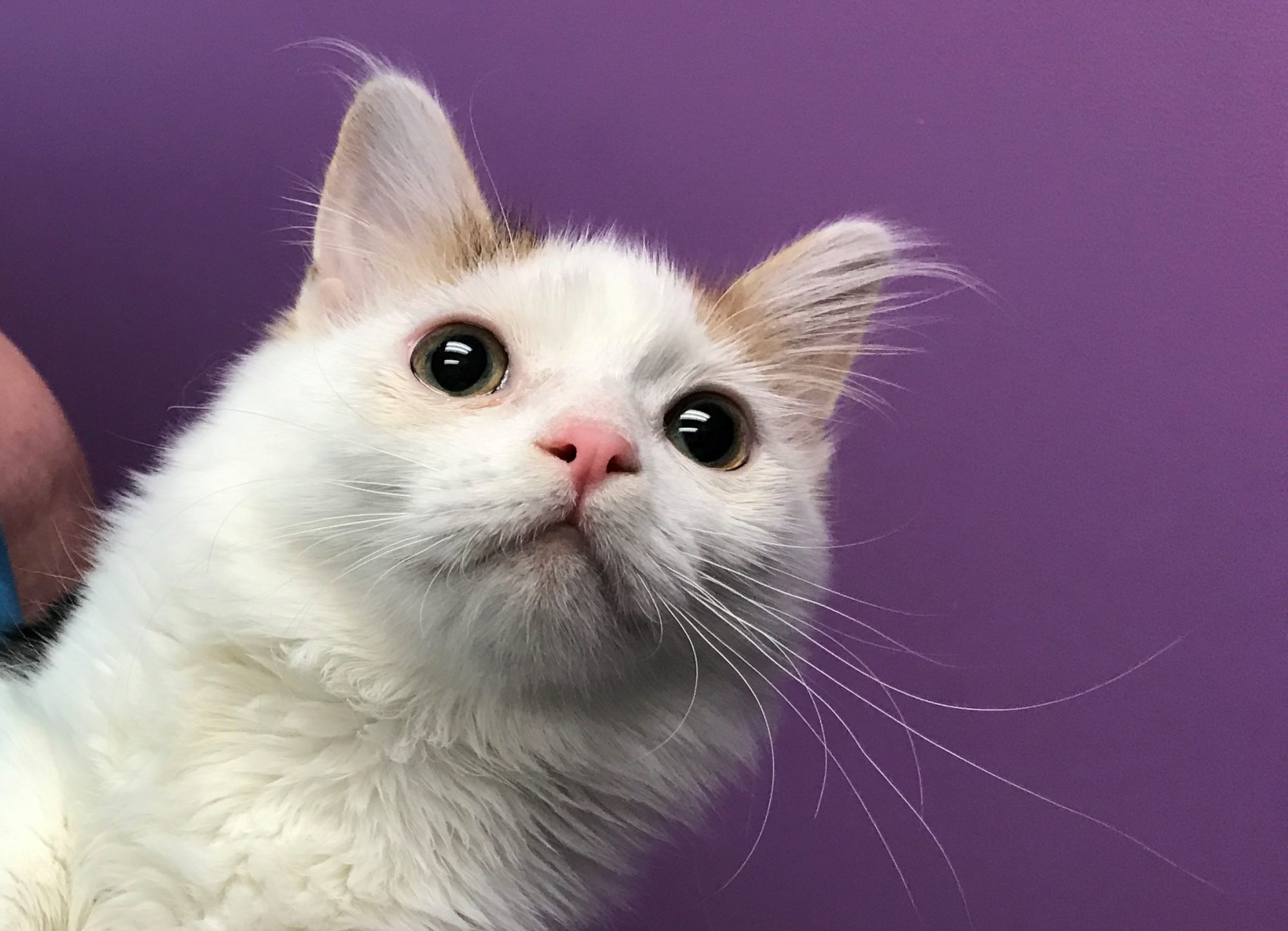
This is an abnormal opening in the roof of the mouth that allows food to go into the nose. This causes gagging, choking, severe sneezing, infections of the nose and difficulty breathing.
In addition, affected pets don’t thrive. They are typically malnourished because it’s difficult to feed them enough to help them grow.
When her owner reached out to me to help with the surgery, Callie was only 6 weeks and weight only 1 pound. Her incredibly dedicated owner had already been through a lot, since she had bottle fed Callie from birth.
Doing surgery to close the “hole” in not recommended in such a young kitten.
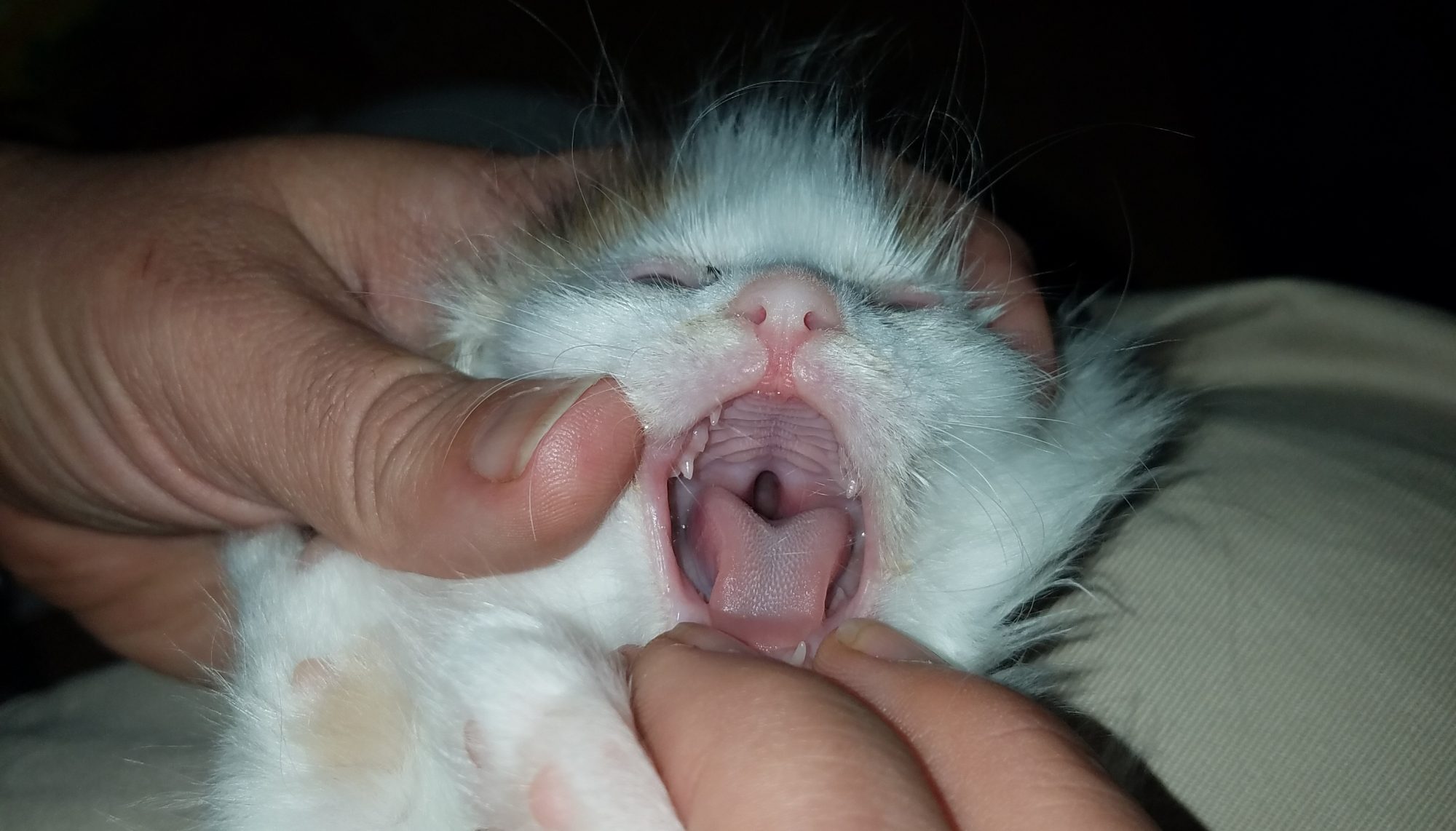
Callie at 6 weeks of age
So we agreed that we would try to hang in there until Callie is older and stronger. She needed to be a better candidate for anesthesia and surgery. Until then, family members had to take turns to feed Callie slurry every few hours.
Long story short, Callie grew stronger and eventually had surgery at Brodheadsville Veterinary Clinic (www.brodheadsvillevet.com) when she turned 8 months. On the picture below, Callie is on her back on the surgery table. The red arrow shows the normal part of the front of the roof of the mouth. The green arrow shows the hole in the back part of the roof of the mouth, ie the cleft palate.
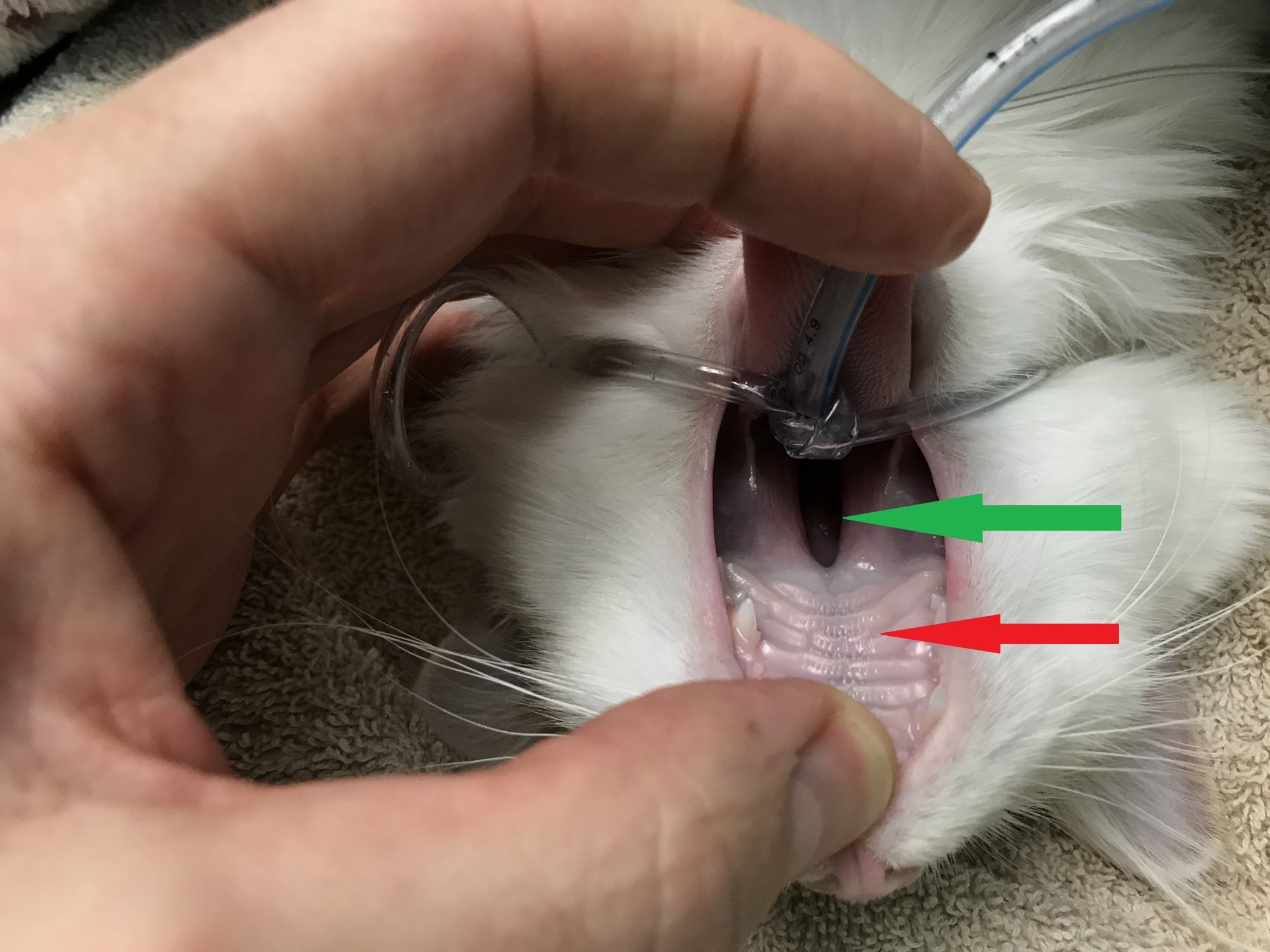
Callie made it through surgery with flying colors and woke up smoothly after anesthesia. The picture below shows the stiched-up opening.
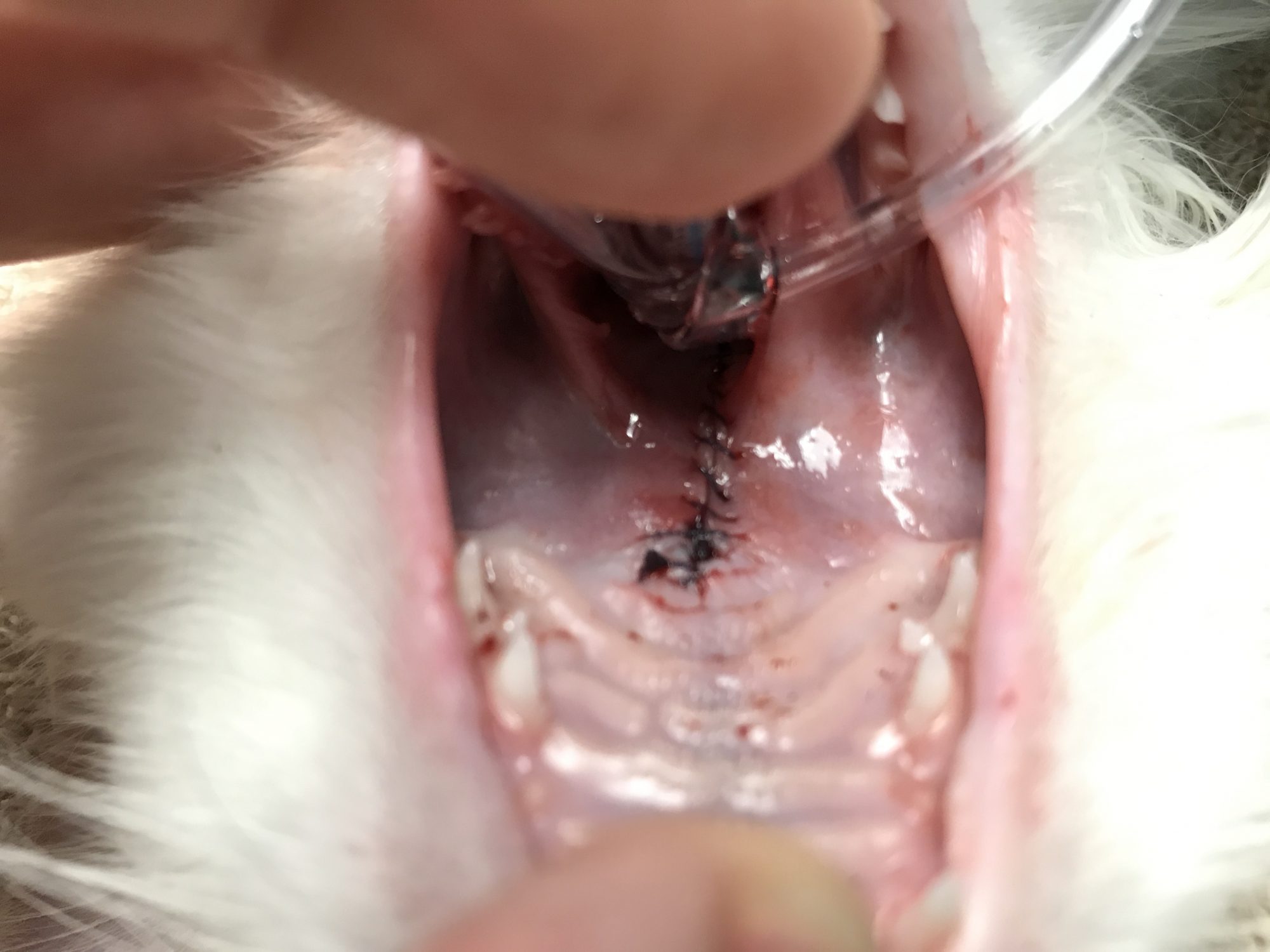
Once home, she immediately started eating whatever was put in front of her. There was no sneezing, coughing or gagging.
Callie’s owner writes: “It was so amazing! I can hardly find words to describe how it felt to see her eat like a normal kitten.” She quickly put on a pound.
About 2 weeks after the surgery, bubbles started to come out of Callie’s nose after eating or drinking. What happened is that one tiny area didn’t heal properly. This can happen, and we had discussed that possibility during the consultation. So we did another surgery, minor this time, to close the tiny pinhole.
“Since that second operation, she has had no problems eating or drinking anything. She seems to prefer dry food over wet, now that she doesn’t have to worry about gagging it up.”
“She just turned 1 year of age and now weighs about 9.5 lbs. She is a happy, energetic, precocious cat that looks like a kitten and we can’t imagine life without her.”
I love Callie’s story because it’s such a perfect example of how one loving human can dedicate so much time of energy and save one tiny kitten’s life.
Many, many people would have given up. But not Callie’s owner. She is now rewarded with a beautiful, healthy cat who can enjoy life.
Phil Zeltzman, DVM, DACVS, CVJ, Fear Free Certified

Dr. Phil Zeltzman is a traveling veterinary surgeon in Pennsylvania & New Jersey. An award-winning author, he loves to share his adventures in practice along with information about vet medicine and surgery that can really help your pets. Dr. Zeltzman specializes in orthopedic, neurologic, cancer, and soft tissue surgeries for dogs, cats, and small exotics. By working with local family vets, he offers the best surgical care, safest anesthesia, and utmost pain management to all his patients. Sign up to get an email when he updates his blog, and follow him on Facebook, too!
Penny gets a new lease on life
Penny, a 7 year old Labrador, was in deep trouble.
She couldn’t go on walks or function normally. She was suffocating because of a condition called laryngeal paralysis (aka “lar par”). This meant that her larynx (or voice box) was paralyzed and didn’t allow her to have enough oxygen on board.
Her owner wrote: “Lately, Penny has had several episodes where she had great difficulty catching her breath, especially after exercise or excitement. The last one of these episodes was severe enough to make her tongue go bluish for a short time.”
She had surgery at Brodheadsville Vet Clinic (www.brodheadsvillevet.com) in Brodheadsville, PA, in order to open up her larynx with permanent sutures (tie-back surgery).
Three days after surgery, her owner writes: “Overall Penny is doing fantastic! Her breathing is immensely improved and our hardest problem right now is keeping her calm.”
She recovered smoothly and two months after surgery, she could go on walks in the woods again.
Here is her story in video: www.youtube.com/watch?v=TvSMSLNeZRs&t=5s
As I always say, laryngeal paralysis is not a death sentence. With the proper care, patients can have a normal, happy life.
Phil Zeltzman, DVM, DACVS, CVJ, Fear Free Certified

Dr. Phil Zeltzman is a traveling veterinary surgeon in Pennsylvania & New Jersey. An award-winning author, he loves to share his adventures in practice along with information about vet medicine and surgery that can really help your pets. Dr. Zeltzman specializes in orthopedic, neurologic, cancer, and soft tissue surgeries for dogs, cats, and small exotics. By working with local family vets, he offers the best surgical care, safest anesthesia, and utmost pain management to all his patients. Sign up to get an email when he updates his blog, and follow him on Facebook, too!
Gilda didn’t act her age…
Gilda, a 4 year old female mastiff, was brought to the emergency clinic for vomiting, depression and lack of appetite.

After the veterinarian did a thorough physical exam, he recommended taking X-rays of the abdomen (belly).
The X-rays confirmed the suspicion: a blockage of the intestine by a foreign body, likely cloth. Pets can eat all sorts of crazy things, such as toys, sticks, rocks etc. Puppies (and kittens) are the main culprits because they are inexperienced and silly. And because they explore their environment with their mouth. However, Gilda was not a young pup, so her foreign body was a little unusual. What compelled her to swallow it?
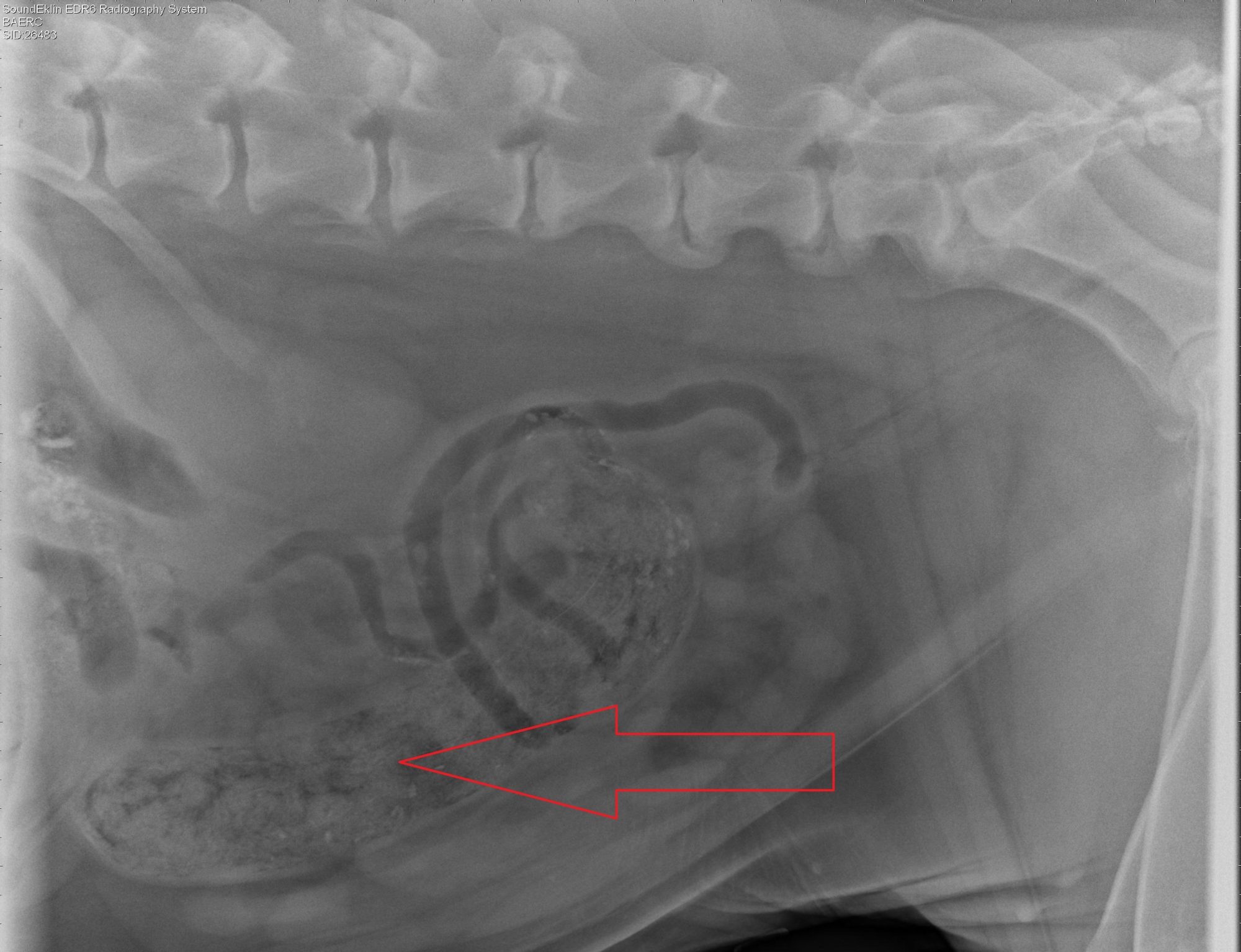
Surgery was performed and sure enough, I pulled a large, twisted up piece of fabric out of her intestine! It was about the size of a hand towel. A biopsy of the intestine was taken before closing the belly.
Gilda recovered smoothly in ICU. She later went home, feeling much better.
After a week, the biopsy results came in and confirmed my suspicion of irritable bowel disease (IBD). This condition is somewhat similar to irritable bowel syndrome (IBS) in humans. It is often the reason why adult dogs (and cats) swallow a foreign body. They feel weird, and they are compelled to eat things they shouldn’t. This is called “pica” (pronounced pie-ka). Classic signs of IBD may include vomiting and diarrhea.
Long-term, Gilda’s owners’ main focus will be to “puppy-proof” the house and the yard at all times, and to only feed a prescription diet to keep the IBD under control. Sometimes, medications are required to treat IBD.
Fortunately, Gilda’s future looks good.
Phil Zeltzman, DVM, DACVS, CVJ, Fear Free Certified

Dr. Phil Zeltzman is a traveling veterinary surgeon in Pennsylvania & New Jersey. An award-winning author, he loves to share his adventures in practice along with information about vet medicine and surgery that can really help your pets. Dr. Zeltzman specializes in orthopedic, neurologic, cancer, and soft tissue surgeries for dogs, cats, and small exotics. By working with local family vets, he offers the best surgical care, safest anesthesia, and utmost pain management to all his patients. Sign up to get an email when he updates his blog, and follow him on Facebook, too!
Ace lands in deep trouble
Ace, a 6 month old Pit bull, was playing outside.
At one point, he jumped up, landed wrong and collapsed. He was painful and held a back leg up.
Ace’s owners took him to the emergency clinic, where X-rays showed a fracture of the left shin bone, called a tibial tuberosity avulsion or tibial crest avulsion (compare the broken part to the right leg, which is normal).
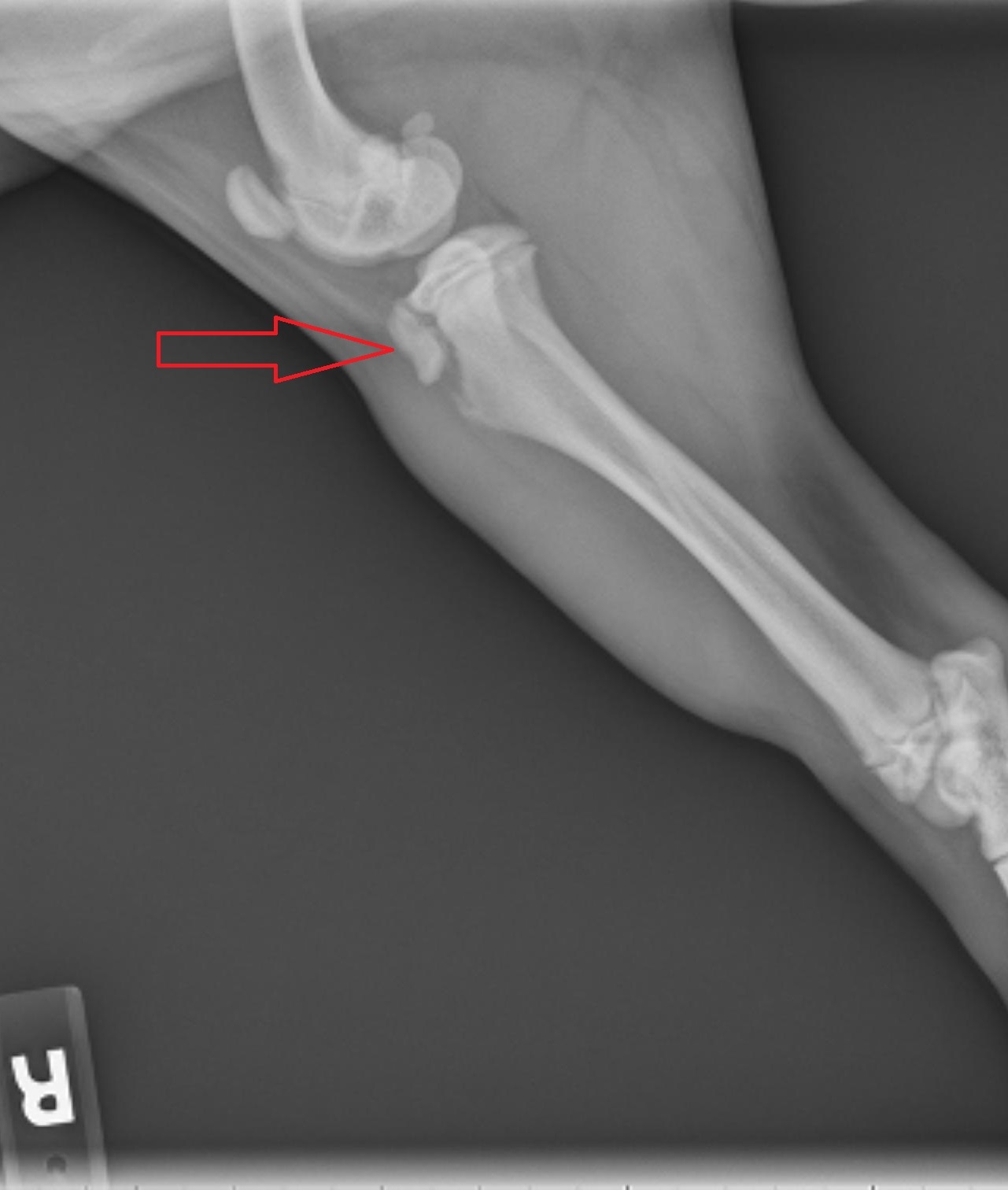
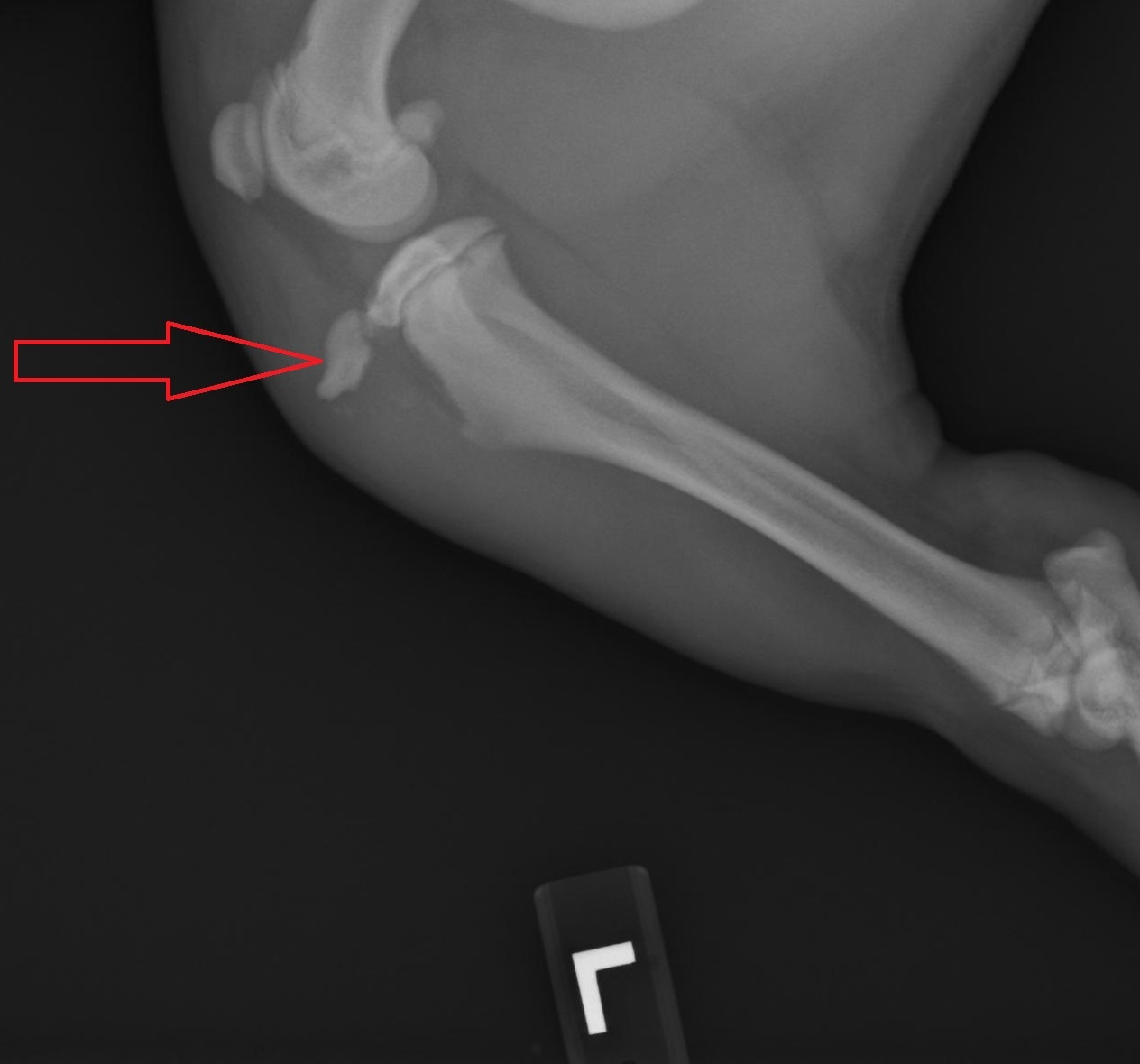
This type of fracture only occurs in growing puppies because it happens through a growth plate. This area allows bones to grow longer. It’s however a weaker area and makes it more likely to break after enough trauma.
I repaired the fracture with 3 stainless steel pins to reattach the fractured bone to the main part of the shinbone.
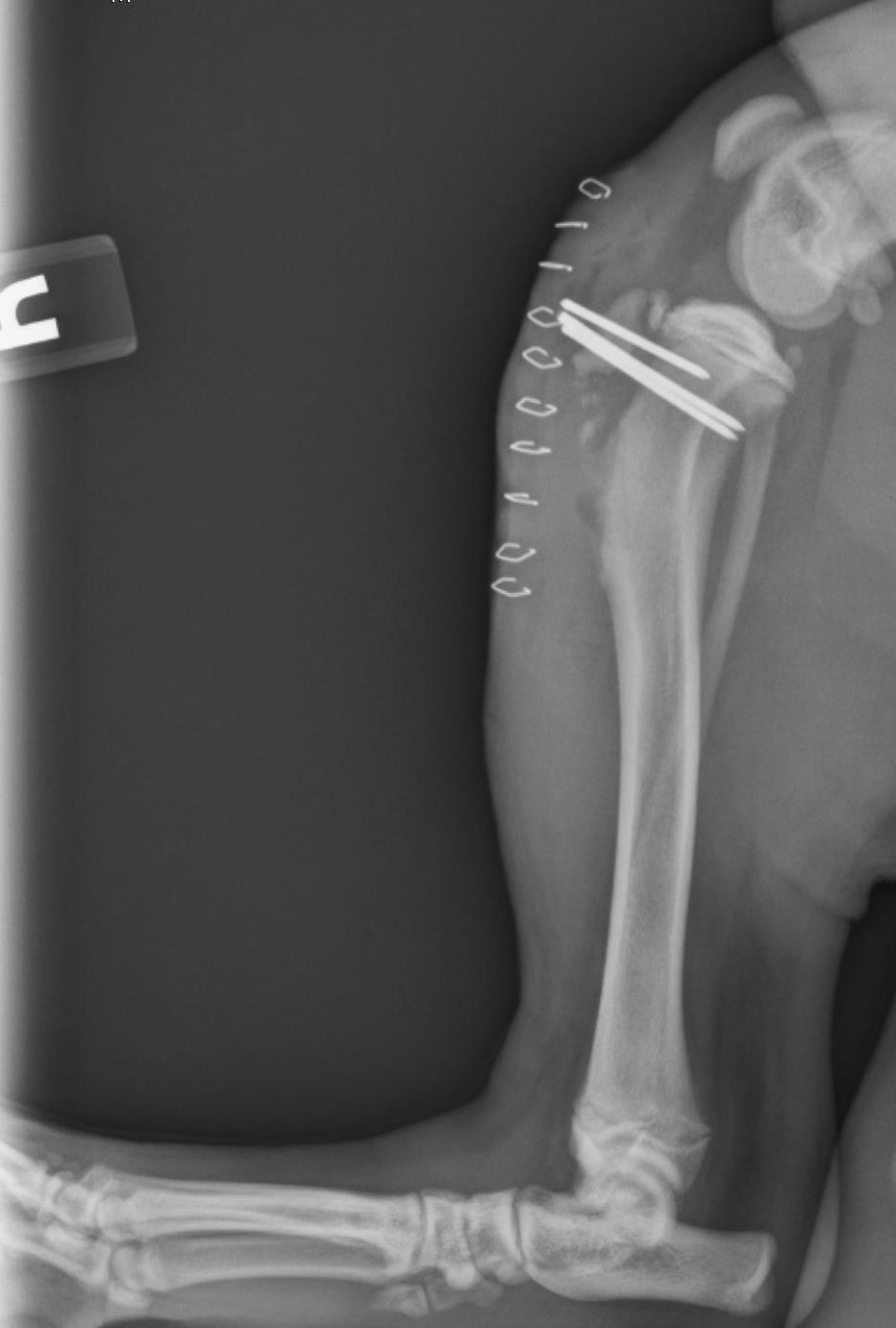
Ace stayed overnight and went home with a plastic cone, antibiotics and pain medications. He had to be confined strictly for 6 weeks. The owner was given instructions to do simple physical therapy exercises.
6 weeks later, X-rays showed nice healing of the bone and Ace continues to live a happy, playful life.
Phil Zeltzman, DVM, DACVS, CVJ, Fear Free Certified

Dr. Phil Zeltzman is a traveling veterinary surgeon in Pennsylvania & New Jersey. An award-winning author, he loves to share his adventures in practice along with information about vet medicine and surgery that can really help your pets. Dr. Zeltzman specializes in orthopedic, neurologic, cancer, and soft tissue surgeries for dogs, cats, and small exotics. By working with local family vets, he offers the best surgical care, safest anesthesia, and utmost pain management to all his patients. Sign up to get an email when he updates his blog, and follow him on Facebook, too!
Scout’s big bad bloody bladder surprise…
Scout, a 9 year old female Labrador, had been having urinary issues for weeks, including frequent urination, accidents in the house and bloody urine.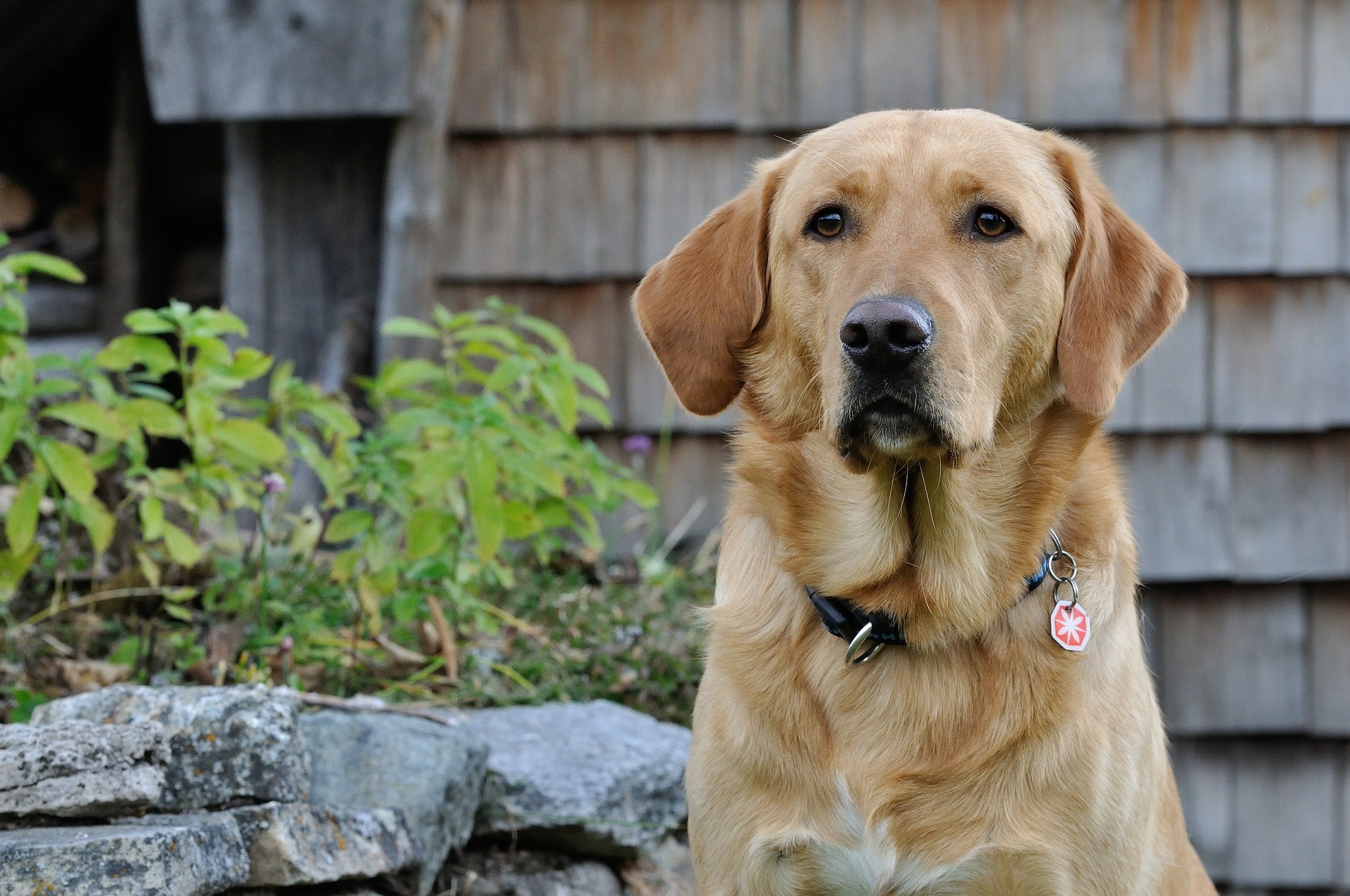
These are classic signs for a urinary tract infection. So Scout was treated with antibiotics. There was no improvement. Another round of antibiotics was prescribed: still no improvement. When antibiotics don’t resolve a presumed bladder infection, it’s time to explore other less obvious diagnoses…
An ultrasound was recommended. It revealed a big mass in Scout’s bladder (see yellow arrows below. The mass is grey-ish, urine is blackish).
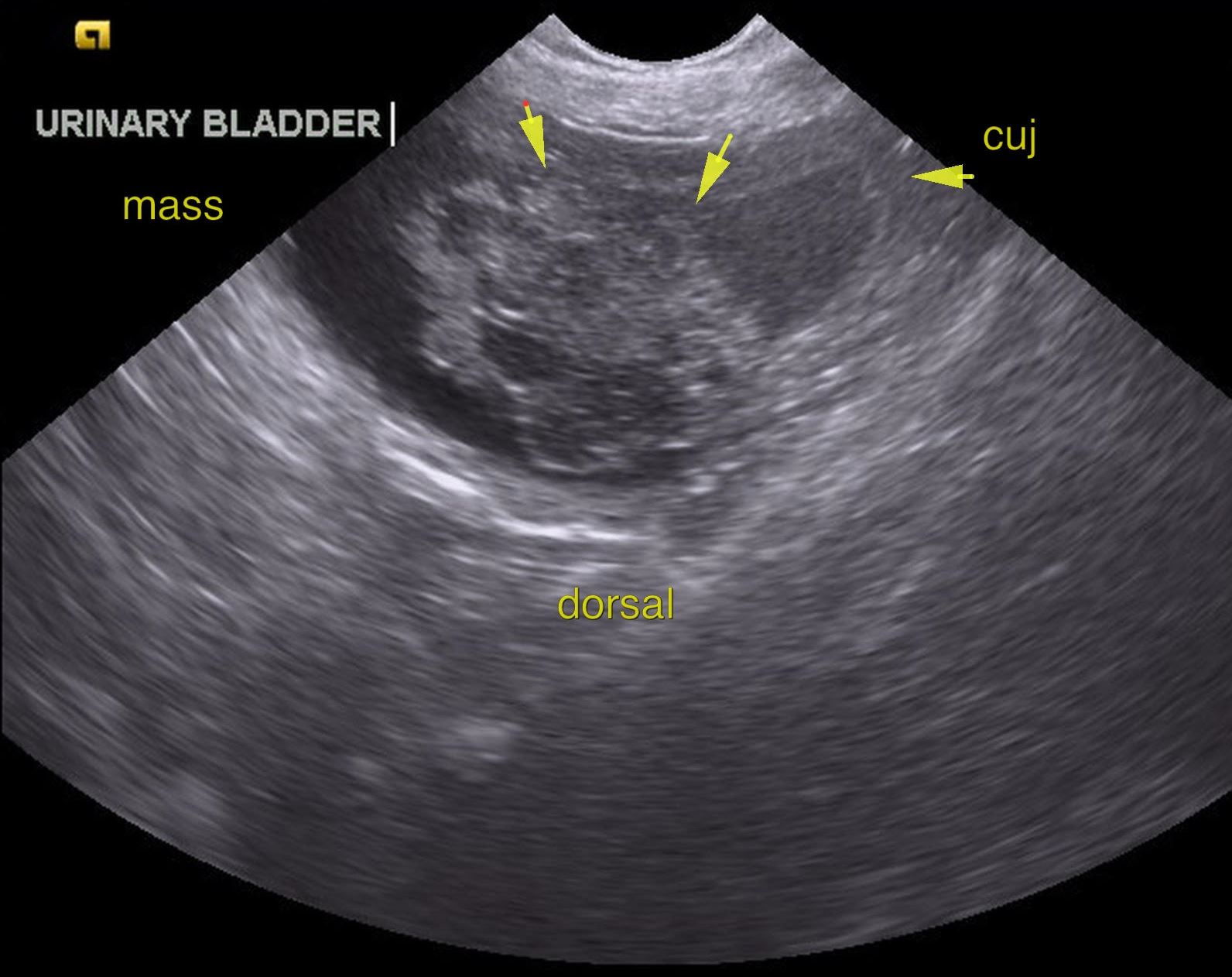
This was bad news since, statistically speaking, the vast majority of masses found in a dog’s bladder are cancerous (most often transitional cell carcinoma).
Regardless, Scout’s loving owners elected surgery to give her every possible chance. Scout underwent a laparotomy (abdominal surgery) to have the bladder mass removed and biopsied. The mass was the size of a walnut. About one third of the bladder had to be sacrificed. The rest of the bladder was reconstructed with multiple stitches. Surgery went smoothly. Scout recovered well, and was sent home the next day.
As expected, she did have a few days of bloody urine immediately after surgery, but it cleared up after a few days.
The mass was sent to the lab for biopsy. After a week of agonizing wait, the biopsy revealed… that the tumor was benign! Despite the statistics, despite everybody’s opinion, and despite the ultrasonographer’s impressions, the mass was… a benign polyp. This was amazingly good news for Scout and her owners!
Three weeks after surgery, my nurse removed Scout’s stitches and commented: “She’s doing great. She’s urinating normally, eating and drinking well, and super happy. Her owners are super happy and thanked us up and down for all our help.”
Remember: a mass is not cancer until the biopsy says so. Please don’t make any drastic decisions based on assumptions and statistics.
Scout was supposed to have bladder cancer, yet ended up with a benign polyp, which will not at all affect her lifespan.
Phil Zeltzman, DVM, DACVS, CVJ, Fear Free Certified

Dr. Phil Zeltzman is a traveling veterinary surgeon in Pennsylvania & New Jersey. An award-winning author, he loves to share his adventures in practice along with information about vet medicine and surgery that can really help your pets. Dr. Zeltzman specializes in orthopedic, neurologic, cancer, and soft tissue surgeries for dogs, cats, and small exotics. By working with local family vets, he offers the best surgical care, safest anesthesia, and utmost pain management to all his patients. Sign up to get an email when he updates his blog, and follow him on Facebook, too!

